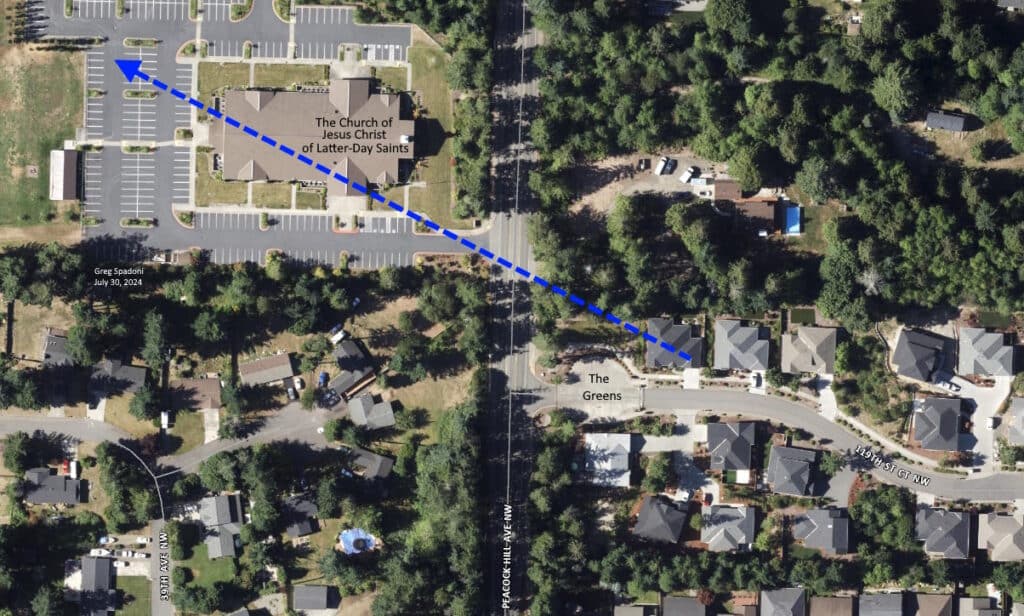Arts & Entertainment Community
Gig Harbor Now and Then | Park, church and more now stand at former railroad crossings
Our last question of local history concerned one of the several Peninsula logging railroads of the early 20th century. With the continuing development of the Peninsula, more of the old logging railroad grades are being destroyed nearly every year, leaving the remaining ones harder to find. But we know they crossed a number of state and county roads. The difficulty is figuring out where. That leads us to the question:
Arts & Entertainment Sponsor
Arts & Entertainment stories are made possible in part by the Gig Harbor Film Festival, a proud sponsor of Gig Harbor Now.
Where was the southern crossing of the Gig Harbor Timber Company’s logging railroad on Peacock Hill Avenue?
Answer: It crossed the county road from east-southeast to west-northwest, through the housing development The Greens, on the east side of Peacock Hill Avenue, to the Church of Jesus Christ of Latter-Day Saints on the west side of the road. The company logged both properties via timber contracts with the owners.

The railroad of the Gig Harbor Timber Co. came up the hill from the east through what is now The Greens neighborhood, logging the old-growth fir and cedar as it progressed.

After crossing what is now Peacock Hill Avenue, the logging railroad entered the property now occupied by the Church of Jesus Christ of Latter-Day Saints, diagonally across the south entrance.
Proceeding into the forest on the west side of Peacock Hill Avenue, the railroad went through what is now the southwest corner of the LDS building.
I wonder if that was reported on the church’s Environmental Impact Statement?

In 1911, after traversing the current site of a new home on the east side of Peacock Hill Avenue, the tracks of the Gig Harbor Timber Co.’s logging railroad passed through the space now occupied by the LDS building on the west side of the county road. Pierce County Assessor-Treasurer aerial base map.
I also wonder if there’s a Railroad Crossing sign inside the building.
Following those railroad tracks
In 1911, after two years of logging in Crescent Valley and on Peacock Hill, the Gig Harbor Timber Company was nearing the end of its business life. To finish up, its logging railroad crossed Peacock Hill Avenue at the future site of the LDS Church on its way to the westernmost edge of its operations.
After logging the present-day church land (which was a square 40-acre piece at the time), the company secured an easement to cross a quarter mile of land it did not own or log, to reach its last parcel of timber. It was an irregular-shaped 120 acres.
That brings up today’s question:
What well-known spot marks the western edge of the Gig Harbor Timber Company’s logging?
Hint: it’s crawling with people every day of the year.
We’ll have the answer on Aug. 26.
Another logging railroad crossing
The railroad crossing of a local county road we can probably get the next closest to locating is the very first one by the Gig Harbor Timber Co. It was at the intersection of today’s Verhardson Street and Randall Drive, on the east side of Gig Harbor. We can place it somewhere inside about a one hundred-foot-wide strip. That’s somewhat close, but not nearly so as with the company’s southern crossing of Peacock Hill Avenue.

The first crossing of a county road by the Gig Harbor Timber Co.’s logging railroad was at the intersection of today’s Vernhardson Street and Randall Drive. The tracks went through what is now Crescent Creek Park. Pierce County Assessor-Treasurer aerial base map.
Short on substance
With less than 600 words so far, this week’s column is in serious need of some bloating filler. Lucky for us, we specialize in bloating filler.
Reaching way back into the archives, I found an interesting exercise in writing composition that doesn’t pertain to local history. But it’s not like anybody’s actually going to read it, so what difference does it make?
In this piece from 2001, an old friend who’s since passed on, Sherri Silesky, chose four words. I, too, chose four words. We then each wrote a very short story containing those eight words, not knowing what the other had written.
The two stories are radically different. Whether they’re interesting is another matter altogether. What’s not in doubt is that they provide just the right amount of bloating filler this week’s column needs, and that’s justification enough, isn’t it?
The eight words are pandemonium, Smitherman, eclectic, ecstatic, dogmatic, clairvoyant, obsolete, and ridiculous. Sure, eight words are not very many, but we had to establish some sort of limit, and they served the purpose quite well.
First up, Sherri Silesky:
Mr. Smitherman was ecstatic when he opened his mail to find a window envelope that read “You May Already Be a Winner” written across the top. Among all the eclectic pieces of mail he received each day, his clairvoyant gift told him that although others thought such kind of mail was ridiculous, this was something he should attend to, and quickly.
Since he had been out of town on business for several days, he checked the date on the envelope to be certain the offer was not obsolete, and to his pleasure, it was not. His butler Jasper was dogmatic in his belief that such offers caused pandemonium for the adult children of people like Mr. Smitherman, who often had the thankless task of managing their parents’ finances.
A thankless task indeed, but fate was about to provide that Mr. Smitherman’s children would not bear such a burden …
It’s interesting that Sherri chose to write a serious, thoughtful piece, considering that she was one of the funniest people I’ve ever known. She could write howlingly funny stuff. But like all the rest of the funniest people I’ve known, she could also be very serious.
Sherri did end her story with a tease that maybe more was to come, so maybe she had some funny stuff planned for Mr. Smitherman’s kids. We’ll never know.
My turn:
‘Twas at once a ridiculous and sad episode in the history of our company. Dazzled by the romantic image of investing in a real, working, producing precious metals mine, we sent our most trustworthy employee, Mr. Smitherman, to confirm the glowing production reports of the fine gentlemen who were to sell us the mine. We were wary, having received cautions from a slew of experienced mining engineers who claimed the Lemon Sucker Mine was played out and its equipment obsolete. Among the precious metals nearly overflowing from the mine, the owners assured us, were gold, silver, platinum, palladium and pandemonium. Oh, the riches that awaited us!
Mr. Smitherman set about his assignment with our company’s typical dogmatic approach — methodical, thorough, step-by-step, yet disastrously careless. We had hoped that Mr. Smitherman‘s eclectic professional background would see him through in fine fashion, but it was not to be. While observing a mine employee loading blasting charges into a case for transport, Mr. Smitherman unwisely reached for one of the blasting caps out of a simpleton’s curiosity. In an unfortunate turn of events, his polyester wash ‘n’ wear suit generated, and his pudgy little hand transferred, a spark of ecstatic electricity, setting off the powerful explosives. As can be expected, poor Mr. Smitherman was blown to … well, Smithereens.
Had we been clairvoyant, we could’ve avoided sending Mr. Smitherman to his demise. On the other hand, had HE been clairvoyant, he could’ve avoided that accidental spark.
I don’t recall if Sherri accused me of cheating, but she may have had grounds for doing so. My use of some of the eight words weren’t exactly according to Hoyle, although in my defense I’ll point out that the meanings of words are constantly evolving. I was simply helping that evolution along. Either that, or I was helping them regress. One of those two.
The next column
With any luck, our next column, on Aug. 26, won’t need any bloating filler. It may end up with enough bloated subject matter. At least that’s what we’re aiming for.
In addition to providing the answer to today’s question, we’ll pose a new one, and we’ll also trace the early ownership of a well known Gig Harbor property. Much like the college land in Gig Harbor owned by the state of Mississippi in the 1860s and 70s, it had some very unlikely out-of-state owners. Unlike the college land owned by the state of Mississippi, we couldn’t figure out why. All we know is that it had nothing to do with land grants.
— Greg Spadoni, August 12, 2024
Greg Spadoni of Olalla has had more access to local history than most life-long residents. During 25 years in road construction working for the Spadoni Brothers, his first cousins, twice removed, he traveled to every corner of the Gig Harbor and Key Peninsulas, taking note of many abandoned buildings, overgrown farms, and roads that no longer had a destination. Through his current association with the Harbor History Museum in Gig Harbor as the unofficial Chief (and only) Assistant to Linda McCowen, the Museum’s primary photo archive volunteer, he regularly studies the area’s largest collection of visual history. Combined with the print history available at the Museum and online, he has uncovered countless stories of long-forgotten local people and events.

